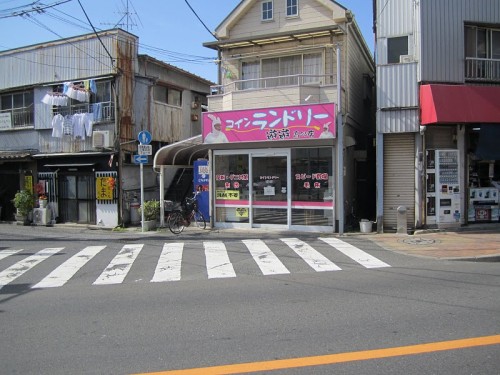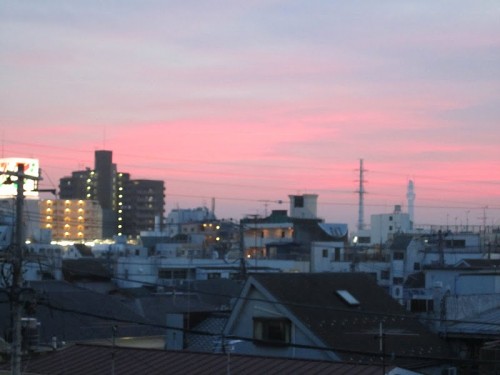
Gaudy bunnyman laundromat near my place
It’s been about two months since I moved from Ayase to Shibamata, an area of Katsushika-ku about a 20-minute drive away. My life since then has been a mix of busy and overwhelming, but as a way to ease myself back into blogging I’ll offer some first impressions of the new neighborhood.
Shibamata is well-known as the setting for the Otoko Wa Tsurai Yo film series. It’s about a guy named Tora-san who works as a traveling salesman whose cantankerous attitude and pratfalls cause mayhem and drama for his family in Tokyo who sells rice dumplings outside Taishakuten, a big temple in the area. He is considered something of a hero to Japanese men who grew up a generation or three ago.
My apartment is maybe 15 minutes on foot from Taishakuten. The main attractions are the exquisite temple and a run-up of shops selling souvenirs and dango rice dumplings. If you had no clue about the movies, the general atmosphere would seem like a scaled-back version of Asakusa except for all the trinkets featuring a guy in a cheap suit and fedora.
Away from the touristy spots, my new place is in many ways not that different from Ayase. Katsushika-ku and Adachi-ku are both considered “shitamachi” (lower-class outlying Tokyo neighborhoods), and my neighborhood does not disappoint on this front. In fact, I live amidst a surprisingly thriving shotengai business district which offers competitive and attractive alternative grocery options to the Ito Yokado by the station, provided you’re willing to visit multiple stores.

You can see the Sky Tree from my apartment. When completed it will be the world’s tallest… something
Another related similarity is the general slumminess (for Japanese standards). I feel bad saying that though because even though both places feel kind of run down, the people and atmosphere in my new neighborhood are much sunnier. The police say Katsushika-ku has less crime than Adachi-ku (PDF), but by population the smaller Katsushika is pulling its weight just fine (2/3 the population with 3/4 the number of crimes). At the anecdotal level, I have witnessed:
- A crippled old guy escaped from a nursing home, sitting on his butt and pushing himself along on his hands trying to get somewhere (long story short, he had his facility name on his slippers, so I called to make sure they got him).
- Obvious yakuza held a boisterous mikoshi parade around my station.
- Something (probably human) left an enormous crap on the sidewalk one night.
- A local dentist I visited was like something out of the Addams Family or the Saw movies – it was just in this guy’s house, and the office was dank, dark, and cluttered with unused equipment. Half the counter space was taken up by a bonsai tree and a fountain that he must have set up in the 80s.
- Some drunk guy puked in my building’s lobby (oh wait, that was one of my guests…)
To offer a positive spin, these elements add lots of character and should keep our lives interesting. For the most part, it’s a great place to live so far. It’s a quieter neighborhood, many of the local people are friendly, and there’s a really nice public pool and a state-of-the-art central library nearby. And the best part is I am living in a much bigger place, for about the same rent. Having room to swing your arms around is extremely comfortable!
Also, for some reason my new commute on the Keisei line is so much less crowded than most of the other routes into Tokyo. From where I ride it’s often possible to get a seat, and it’s just about never uncomfortably packed.
Anyway, I will keep my eyes open! I have been meaning to go around with my camera to capture some of the local color.

Yeah Katsushika! I am at Kameari, and the wife’s family are about three generations of local shop keepers, so I am getting well integrated… for a 6′ paleface. I too like the atmosphere, but god the E side could use some trees!
“A crippled old guy escaped from a nursing home, sitting on his butt and pushing himself along on his hands trying to get somewhere (long story short, he had his facility name on his slippers, so I called to make sure they got him).”
I don’t want none of that — full story please!
P.S. Sky Tree will be the second tallest manmade structure in the world, following the Burj Dubai/Khalifa.
It’s also a retardedly useless waste of money. I can’t believe they’re building a giant TV broadcasting tower, when everybody will just be watching video over the wireless Internet in a decade or so.
Wireless internet needs transmitters too…
Roy, it’s entirely possible, but consider that the services broadcast by the tower can be received essentially for free, and that many people would not give up their analog TV without being forced to by its discontinuation.
Until last year, we got our TV signals from fiber (NTT’s Hikari TV). When they started dropping channels we watched for channels of no interest to us, we had three new antennas installed, for terrestrial digital, BS digital/CS, and SkyPerfecTV HD. Now we can view any channels we want, without depending on a cable provider’s selection or on Hikari TV’s selection. I suspect that in the near term, at least, more people will choose to view programming from Sky Tree than will sign up for a fiber or wireless Internet TV/video service. In the long term, I don’t know.
The government also plans to use the tower for emergency broadcasts, IIRC, since its coverage range will be a lot wider than the existing Tokyo Tower.
Wireless internet relies on a huge number of tiny transceivers – hence “cell.” Big towers like this are totally irrelevant.
Wataru – it’s true that some amount of demand for TV broadcasting will remain, but I just don’t see how it can possibly be enough to justify taking a chunk of prime real estate to build the world’s tallest thingy, that isn’t even dual purpose. Why not at least get a sky scraper with, you know, rooms inside it, and just stick a big transmitter on top, like in NYC?
sounds interesting, but a bit of a dump
Right, like I said it’s going to be the world’s tallest sky tree.
Oh a couple other things I’ve seen:
Guy with fresh bleeding scratches on his head sitting on a bench staring dazed at his bankbook.
Homeless dude sitting on the sidewalk slowly tearing the pages out of an issue of Shonen Jump and littering them on the street.
Hapless fat middle aged women crash her bicycle into the side of a building and fall hard on the road because she was trying to carry 10 1.5L bottles of green tea that were on special.
Japanese love their towers. I suspect it is already a huge revenue generator and will become even more of one, both for the surrounding community and for the two observation decks, etc. in the tower itself.
To elaborate a bit more, Sky Tree is more than utilitarian; it’s meant as a symbol or object. Cities aim to build the next Eiffel Tower, the Statue of Liberty, or the Golden Gate Bridge. It costs more to keep painting that bridge the current reddish color than an industrial grey, but the value of the red color is huge.
As for making it an office building, that would have to be done as a private-sector project, and I doubt there are any real estate corporations willing to invest in a huge commercial skyscraper in that location.
Pathetic places have to keep building higher, and I am sad to see my much-loved Tokyo in that group. You build the tallest tower and you have beat sad places like KL and Dubai for a year or two.
Japan has generally good infrastructure, so things like the Sky Tree fall into the “What do you get for the guy who has everything” category. These types of things are almost ridiculous by nature.
@Wataru – there is that aspect, of course. But I dunno, this project just seems so overwhelmingly uncreative compared to all of those examples. Yes, it’s a decent enough design, but it certainly doesn’t have the novelty that the Eiffel Tower had, or even the much, much less interesting Tokyo Tower.
men like big penis towers and rockets.
perhaps if women ruled the world we’d have better buildings
women love penises yes, but not penis towers
If the Sky Tree were the anchor point for a space elevator, I would be all for it. In fact, that is exactly what Japan should be pouring research money into – although you would probably want to build it closer to the equator, on Okinawa, and certainly not in the middle of Tokyo.
“Japan has generally good infrastructure”
I frequently make that claim too but I’ve been wondering recently how true it still is. Japan’s high rating in global competitiveness surveys is often based on a strong infrastructure score. Tokyo still seems to run with a higher level of efficiency than I experience in other major cities but I’ve met a few specialists in recent years who have raised questions about Japan’s energy grid, waste and water treatment facilities, ports and airports and urban planning in general.
I don’t have the expertise to judge whether these people are really making valid points. They might just be disappointed by the gap they have encountered between their own expectations for Japan to be cutting edge in all things and a more prosaic reality. Even if they are right and, say, Japan’s sewers score 6/10 against some other nation’s 8/10, a range of 6/10 scores across everything may still make up a very healthy infrastructure, especially when Japan suffers from a high incidence of natural disasters.
I can be susceptible to views which seem outside the consensus but it could well be that the consensus continues to be correct. I do recall, though, that a Swiss engineer once correctly pointed out weaknesses in maintenance schedules in Japan and evidence for that began to pile up once corporate investment slowed down many years later.
There was a Closeup Gendai episode a couple months ago about how Tokyo’s sewer systems were built mostly more than 40 years ago and many are in bad need of replacement. There have been some accidents but not many. There might be more on the horizon. It’s tough to have so many civil engineering projects and keep track of all their maintenance needs.
Related
http://ikedanobuo.livedoor.biz/archives/51497486.html
http://ikedanobuo.livedoor.biz/archives/51460084.html
“I frequently make that claim too but I’ve been wondering recently how true it still is.”
When I was originally typing that comment, I wrote “excellent” instead of “good”, but decided to be more conservative because of some of the very issues that you raised.
What country is being used as the standard of comparison is also important – if you compare, say, central Canada or much of the United States (especially energy grid), Japan comes out looking golden. If you include trains in “infrastructure”, Japan (and Tokyo for subway), should get a boost.